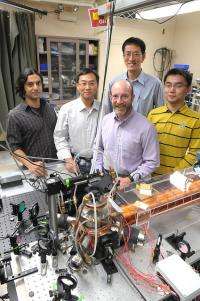Argonne physicist Zheng-Tian Lu (in back) and his team (from left to right: Arjun Sharma, Wei Jiang, Kevin Bailey, and Guomin Yang) stand with the ATTA device, which measures individual atoms of the isotope Krypton-81 as part of an effort to model underground aquifers and predict how fast they refill.
Cataloguing underground waterways, some of which extend for thousands of miles, has always been difficult—but scientists at the U.S. Department of Energy's (DOE) Argonne National Laboratory, with colleagues from the University of Illinois at Chicago and the International Atomic Energy Agency, are mapping them with some unusual equipment: lasers and a rare isotope.
About a fifth of people on Earth drink water drawn from underground, and crops around the world depend on it; experts believe that aquifer depletion contributed to the worldwide food drought this year. Underground water is less prone to pollution and is the only source of water in many dry areas where surface water quickly evaporates.
Water accumulates in aquifers only after filtering slowly through sand and cracks in rocks, which can take millennia in some areas. In order to manage this resource fairly and effectively, consumers need to know how fast the water is replenished.
But because the areas that feed aquifers can extend for thousands of square miles—and conditions over any of those areas affect them—it's been difficult to get an accurate model of the entire system. Good models could predict water availability according to changes in vegetation, terrain, rain, droughts or monsoons.
What scientists needed to improve their models was a way to calculate the "age" of the water, or how long the water has been underground.
When water spends time above ground, it picks up tiny traces of isotopes that are naturally present in the air. One of these is krypton-81, an atom that decays extremely slowly. The technique is similar to carbon dating done on fossils: if you know how slowly Kr-81 decays and can count the remaining Kr-81 atoms in the water, you can calculate how long it's been since the water was above ground.
Scientists have been hoping for a way to use Kr-81 for dating since the 1960s; it's a remarkably long-lived isotope that can be used to date back much further than carbon—perhaps as far back as a million years. But since the isotope is extremely rare in the atmosphere, researchers needed a way to measure incredibly small amounts of atoms.
Laser trapping and cooling of atoms, an area of physics pioneered by Energy Secretary Steven Chu, turned out to be the answer. Argonne physicist Zheng-Tian Lu leads a team that has worked since 1997 to adapt Chu's atom trap to count individual atoms of Kr-81. The result is called Atom Trap Trace Analysis (ATTA), which combines lasers with a camera to image atoms.
The device uses a chamber with six laser beams to capture individual atoms. To set the trap to catch only Kr-81 isotopes, scientists tune the lasers' frequencies to match the specific resonances of Kr-81 atoms. Atoms vibrate at frequencies that are specific to each isotope. When they're hit by resonant light, they become excited and vibrate faster—and show up as a bright spot on the camera.
Lu partnered with University of Illinois at Chicago geologist Neil Sturchio to use ATTA to perform a sample study to determine the age of the Nubian Aquifer in the Sahara Desert. The analysis agreed with independent hydrodynamic models, confirming the flow of water toward the northeast and even indicating flow rates at approximately one meter per year.
Both Lu and Sturchio are now partnering with Pradeep Aggarwal, who leads the Isotope Hydrology Section at the International Atomic Energy Agency, to conduct a larger-scale study. The team collected samples in Brazil last year, which were sent to Argonne for analysis. If the study proves successful, the technique could be used to map aquifers and groundwater all over the world.
More information on ATTA is available online. This project is funded by the DOE's Office of Science. The study of the Nubian Aquifer was funded by the DOE Office of Science and by the National Science Foundation.
Provided by Argonne National Laboratory






















